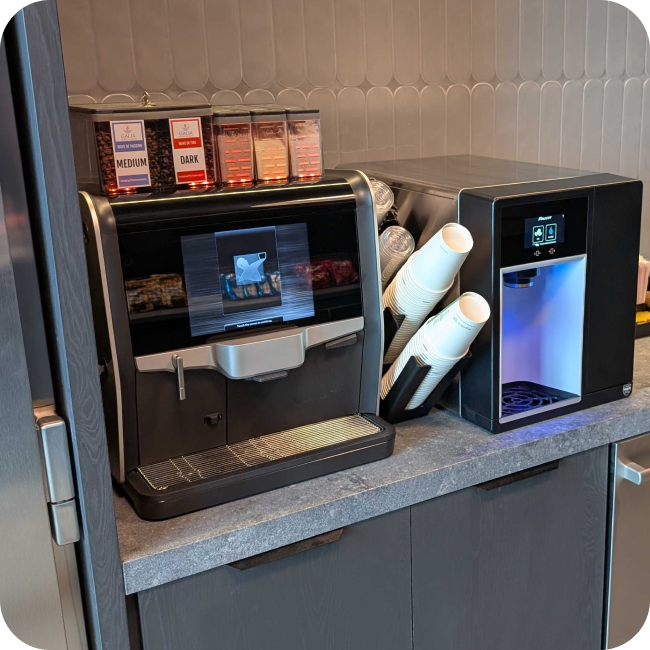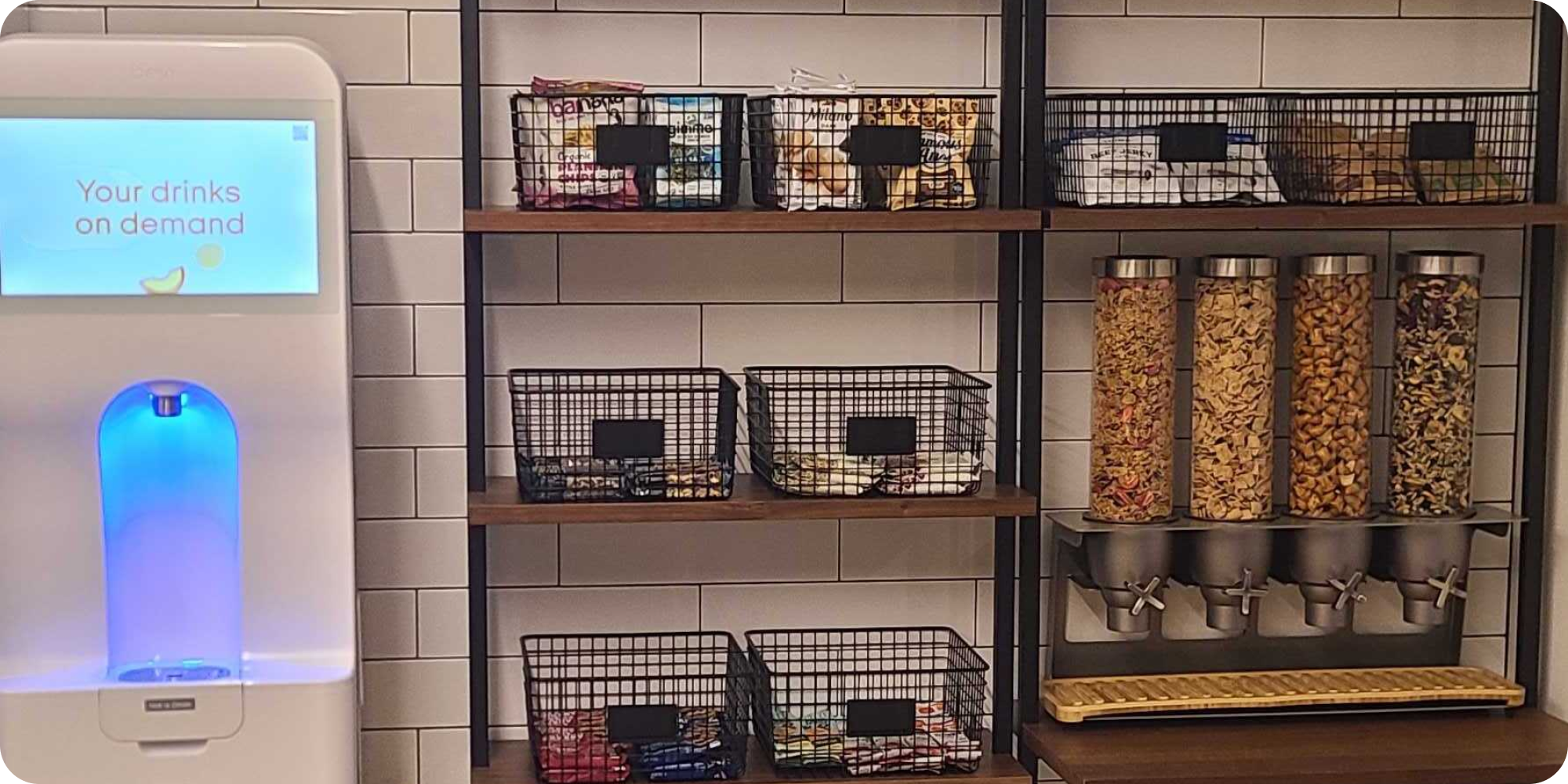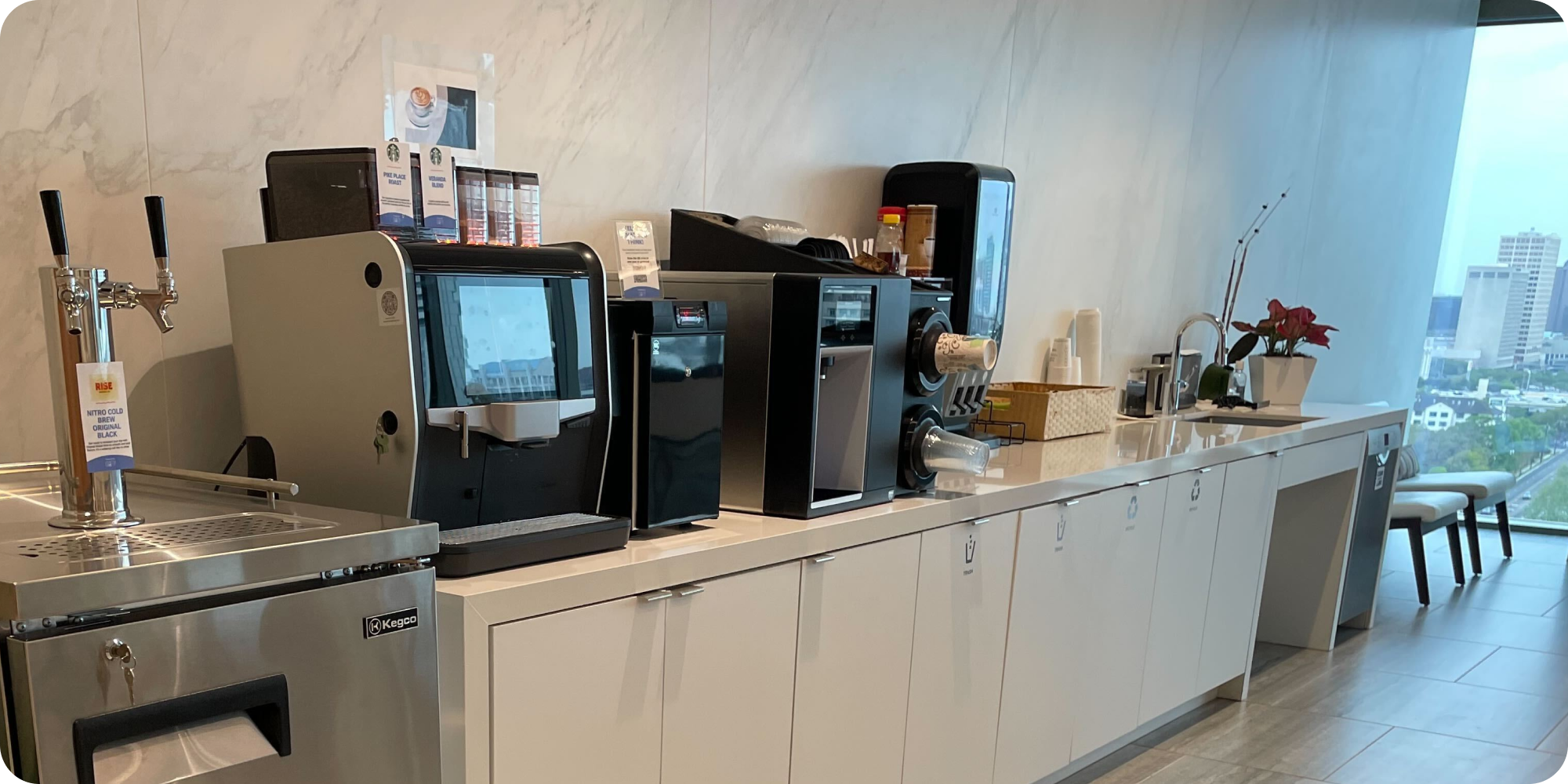Office Kitchen Equipment Guide:
Bean-to-Cup Coffee Machines for the Office
The pros, cons, and key considerations of bean-to-cup coffee machines for your workplace.
✍️ Written by Rebecca Ross 🕚 15-Minute Read • Updated Thursday, August 14, 2025

Table of Contents
- What is a bean-to-cup coffee machine?
- How does a bean-to-cup coffee machine work?
- What kind of coffee drinks can it make?
- What are the benefits of a bean-to-cup machine?
- What are the downsides?
- What beans work best for bean-to-cup machines?
- How much maintenance does it take?
- What should you consider when choosing a coffee machine?
- What are the top bean-to-cup machines for offices?
- How does a bean-to-cup machine compare to other coffee machines?
When it comes to coffee at work, there’s no one-size-fits-all solution. Some teams prioritize speed and convenience. Others want a high-quality coffee experience that feels like their favorite coffee shop. If you’re considering an upgrade, bean-to-cup coffee machines might be exactly what your team needs. They bring a touch of café quality to the workplace, and in this guide, we’ll walk through how these machines work, what makes them unique, and how to know if they align with your team’s coffee habits, goals, and budget.
What is a bean-to-cup coffee machine?
A bean-to-cup coffee machine is a fully automated system that grinds good coffee beans and brews each cup fresh on the spot. These machines are designed to deliver high-quality espresso drinks without the need for a separate grinder, espresso machine, or barista. Everything happens inside one unit, making it a simple and efficient solution for bringing café-style coffee into the workplace.
How does a bean-to-cup coffee machine work?
Bean-to-cup machines handle the entire coffee-making process from start to finish. Here’s how it typically works:
- Grind: Whole beans are freshly ground per drink.
- Tamp: The machine compresses the grounds for optimal brewing.
- Brew: Hot water is forced through the grounds, espresso-style.
- Pour: The drink is dispensed directly into the cup.
- Milk (Optional): Depending on your machine, some have powdered milk options while others have fresh milk options. They will dispense or foam up these additions depending on the drink that is chosen.
Many machines have digital interfaces, customizable drink settings, and smart sensors to streamline the process.
What kind of coffee drinks can it make?
Depending on the model, a bean-to-cup coffee machine can make:
- Espresso
- Americano
- Cappuccino
- Latte
- Flat white
- Macchiato
- Mocha
- Hot Chocolate
- Hot Water for Tea
Some higher-end machines offer more drink personalization, like adjusting strength, temperature, and milk ratios.
What are the benefits of a bean-to-cup machine?
Bean-to-cup coffee makers offer a range of advantages that make them a strong fit for many office coffee programs:
- Freshness: Beans are ground on demand, so each cup is as fresh as it gets.
- Variety: A wide range of espresso-based drinks from a single unit.
- Sustainability: Whole beans mean less packaging waste than single-use drinks or pods.
What are the downsides?
Bean-to-cup machines deliver quality, but they come with a few tradeoffs to keep in mind:
- Slightly slower brew time: A lot is going on inside the machine, so brewing times can be a bit longer compared to your drip or pod machines. If you have a huge morning rush, this could result in lines.
- More upkeep: These machines require regular cleaning to stay hygienic and maintain performance, particularly if they have milk options such as powdered or fresh milk.
- Space and setup needs: Bean-to-cup espresso machines tend to be larger and usually need access to both power and water nearby.
What beans work best for bean-to-cup coffee machines?
Not all beans are a good fit for bean-to-cup machines, especially in a high-traffic office setting. To get the best results, you’ll want beans that strike the right balance between flavor, performance, and machine longevity. Here’s what we recommend:
- Roast level: Medium or medium-dark roasts tend to work best. They offer a smooth, approachable flavor profile that appeals to a wide range of palates without producing too much surface oil and has a softer bean, which is easier on the grinder.
- Note on Light Roast: While you can use a light roast, keep in mind that the beans are denser, which can lead to increased wear on the machine over time.
- Flavor profile: Choose blends that are chocolatey, nutty, or caramel-forward. These crowd-pleasing flavors hold up well in milk-based drinks like lattes and cappuccinos, and they appeal to a broad group of coffee drinkers.
- Dual hopper setup: If your machine holds two types of beans, consider offering either a regular and a decaf roast, or a medium and a dark roast. This gives your team flexibility without complicating the coffee experience, while still sticking to roasts that are best suited for espresso-based drinks.

How much maintenance do bean-to-cup machines require?
Here’s the thing about bean-to-cup machines: when they’re well-maintained, they deliver consistently excellent coffee. But if maintenance slips, quality can decline fast. Think bitter espresso, funky milk foam, or simply a machine that stops working altogether. These machines are powerful, but they’re not set-it-and-forget-it. Routine care is essential to keep them running smoothly and your coffee tasting fresh.
Here’s what a typical maintenance rhythm looks like:
- Daily: Rinse drip trays, empty the grounds container, and wipe down the exterior.
- Weekly: Run the machine’s internal cleaning cycle and sanitize any milk components (especially if using fresh milk).
- Monthly: Descale the machine to prevent mineral buildup and inspect key components.
- Quarterly: Check and replace water filters, clean grinder components, and update any software or firmware if applicable.
- Yearly: Schedule a professional deep cleaning and inspection to extend the life of the machine and ensure consistent performance.
Most machines include built-in reminders and step-by-step instructions, but the process still requires consistency. Learn more about coffee machine upkeep >
What are the top bean-to-cup coffee machines for offices?
Here are the three best bean-to-cup coffee machines that consistently perform well across Crafty-powered office coffee stations.
- De Jong Duke Nio with Fresh Milk
A great fit for offices that want café-style drinks with fresh milk. The Nio FM features a clean design, large touchscreen, dual bean hoppers, and an integrated fresh milk system—ideal for delivering high-quality lattes and cappuccinos. - De Jong Duke Nio
The standard version of the Nio swaps fresh milk for powdered milk, reducing maintenance without sacrificing drink quality. It's a strong option for busy teams that want espresso-based drinks with fewer daily cleaning requirements. - WMF 1500S+
Built for high-volume use (up to 180 cups/day), this machine offers extensive beverage customization. It’s ideal for teams who want a full espresso menu, flexible milk options, and detailed user control. A top choice for variety and scale.
What should you consider when choosing a machine?
Choosing the right bean-to-cup coffee maker isn’t just about features—it’s about fit. The best machine is the one that aligns with how your team drinks coffee, how often they drink it, and what kind of support your space can provide. Here’s what to think about before making a decision:
- Headcount: A 20-person office has very different needs than a 200-person headquarters. The machine’s speed, capacity, and hopper size should reflect your team size.
- Volume: Are people grabbing one cup in the morning, or sipping all day long? If each person averages multiple cups a day, you’ll need a machine that can keep up with continuous demand, without slowing down during peak times.
- Drink preferences: Is your team all-in on espresso drinks like cappuccinos and lattes, or would they be just as happy with a fresh cup of black coffee? Some machines specialize in espresso-based drinks, while others focus on simple brews. Know your crowd.
- Milk system: If you’re offering milk-based drinks, consider whether you want a fresh milk system (higher quality, more upkeep) or a powdered milk setup (easier to maintain). This decision also affects cleaning requirements and taste.
- Counter space and infrastructure: Bean-to-cup machines are larger than most pod or drip systems. You’ll need counter space, access to power, and a water line.
- Budget: It’s not just about the cost of the machine itself. Think about the full picture: fresh beans, milk (or milk powders), cleaning supplies, maintenance, and service. These recurring costs add up quickly and should be factored into your monthly pantry or beverage budget. The best machine is the one that fits both your coffee goals and your ongoing resources.
How does bean-to-cup compare to other coffee machines?
If your office values quality, variety, and a premium experience, and you have the foot traffic to support the investment, a bean-to-cup machine can be a game-changer. But if your team prefers quick convenience or simpler coffee setups, other options might make more sense. Here's a quick look at how each one stacks up:
|
Feature |
Bean-to-Cup |
Drip Coffee |
Cold Brew Keg |
Pod Machines |
|
Coffee Quality |
Premium |
Elevated |
Elevated |
Basic |
|
Drink Variety |
Wide |
Standard |
Wide |
Curated |
|
Brew Speed |
Moderate |
Fast |
Instant |
Fast |
|
Budget |
Medium cost/cup Premium quality with moderate cost. Scales well for mid-to-large teams with regular use |
Lowest cost/cup |
Medium cost/cup |
Highest cost/cup Convenience-focused, but adds up quickly at scale. |
|
Upkeep |
High |
Moderate |
Low |
Low |
Conclusion
Choosing a coffee machine for your office isn't just about caffeine. It's about experience, efficiency, and finding the right fit for your team. Bean-to-cup machines deliver premium quality and variety, but they also come with factors like upkeep, space requirements, and cost. For the right workplace, they can transform your coffee program into something people truly enjoy.
Explore the Craftyverse
CRAFT
A BETTER
WORKPLACE
Elevate your office food and beverage program with enhanced services managed in one innovative, centralized platform.


